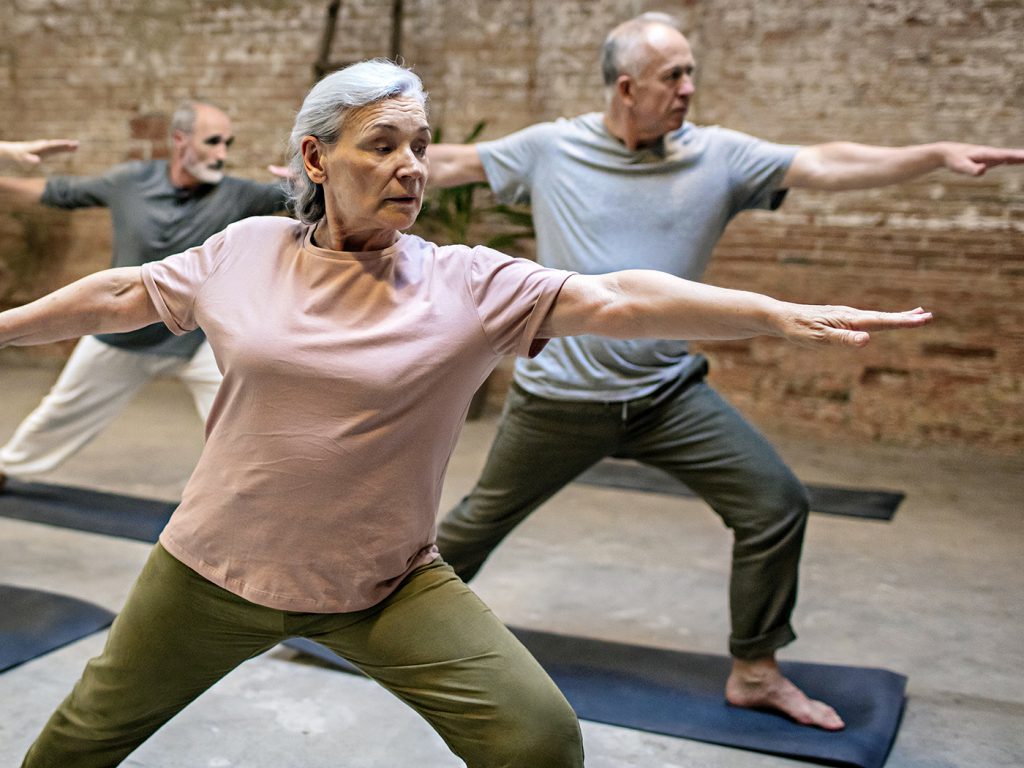Does Yoga Count as a Cardio Workout?
Before you trade the treadmill for a triangle pose, here’s what you need to know.

Yes, yoga is good for you.
“For those 60 and older, yoga is amazing for building strength, improving balance, increasing mobility, and enhancing overall health,” says Josh Hillis, C.P.T., a performance specialist and author of Fat Loss Happens on Monday.
What’s more, research shows it helps with everything from easing back pain to improving sleep quality, mental focus, and mood.
The health benefits of yoga may be unmistakable, but one debate still rages: Can yoga take the place of your cardio workouts?
The answer to that: It depends.
What Counts as Cardio?
All yoga involves a combination of breathing exercises, stretching, strength work, mindfulness, and general body awareness, explains Gabrielle Morbitzer, a yoga and mobility instructor in New York City. But not all yoga raises the heart rate and creates a surge in the body’s use of oxygen in a way that allows it to count as cardio.
For general health, the Centers for Disease Control and Prevention (CDC) recommends performing a minimum of 150 minutes of moderate-intensity cardiovascular activity per week. The CDC defines “moderate-intensity cardiovascular activity” as any movement that increases your heart rate to 50 to 70 percent of your max heart rate.
To figure out your max heart rate, simply subtract your age from 220 beats per minute (bpm). Multiply this number by 0.5 and 0.7 to calculate your 50 to 70 percent range. That means:
For a 65-year-old man or woman:
- Max heart rate: 155 bpm
- 50 percent of max heart rate: 78 bpm
- 70 percent of max heart rate: 109 bpm
For a 75-year-old man or woman:
- Max heart rate: 145 bpm
- 50 percent of max heart rate: 73 bpm
- 70 percent of max heart rate: 102 bpm
Keep in mind these are general guidelines. If you have a chronic condition (such as heart disease or osteoporosis), talk to your doctor about your heart rate goals and safe exercise.
To check your heart rate during exercise manually, follow these steps:
- Pause exercise.
- Turn your hand so your wrist faces up. With your other hand, place the tips of your index and middle fingers on your wrist, below your thumb. Alternatively, you can place the tips of your index and middle fingers on your neck, beside your windpipe.
- Take your pulse for 15 seconds, and multiply by 4 to calculate your beats per minute. If this number is between the 50 and 70 percent of your max heart rate, you’re in the zone for moderate intensity.
What This Means for Your Yoga Practice
If you’re new to yoga, it probably means that your session doesn’t—and shouldn’t—count as cardiovascular exercise, Hillis says. No matter your age, when you’re getting started with yoga, it’s much more important to work on learning the postures and performing them safely rather than moving through them as quickly as possible to get your heart rate up.
Hillis recommends taking an introductory class to learn the basics in a safe and effective way. SilverSneakers Yoga, which is designed specifically for older adults, is a great option, along with restorative, hatha, and Iyengar classes that move at a slower pace.
Whichever class you take, Morbitzer recommends talking to the instructor about any physical limitations you have before getting started. That way, he or she will be ready to suggest modifications when needed.
If you’re unable to attend a class, these five yoga poses every older adult should know—along with tips to make them easier or harder—can help you build a solid foundation.
Subscribe to our newsletter
It's quick and easy. You could be one of the 13 million people who are eligible.
Already a member? Click to discover our 15,000+ participating locations.
Follow Us
Yoga That Gets Your Heart Pumping
Once you become more familiar with yoga, you can increase the cardiovascular benefits by integrating more challenging poses or performing a sequence of poses at a faster pace (less rest between poses).
According to a Medicine and Science in Sports and Exercise review of 17 studies, the Sun Salutation sequence typically counts as moderate- to vigorous-intensity activity. There are different versions of Sun Salutation, but common poses include:
- Forward fold
- Chaturanga
- Upward-facing dog
- Downward-facing dog
- Chair pose
- Warrior one
- Warrior two
A good way to progress is to look for classes described with terms like “power” or “warm,” Morbitzer says. They’ll typically include these poses and move at a pace that gets your heart rate up.
If you have confidence with more advanced poses, you can also practice on your own. “For adults who have the skill and strength to safely move through these high-level poses, this means yoga can take the place of cardio machines,” Morbitzer says.
Above all, listen to your body. “If you can’t get into poses you were once able to get into, don’t push it. Do a modification or use a prop,” Morbitzer says. “Don’t compromise your safety to make your practice count as cardio.”
And always remember: No matter your heart rate, a regular yoga practice benefits your mind and body in myriad ways.
Take Your Favorite SilverSneakers Classes Online!
SilverSneakers members can access live fitness classes and wellness workshops through SilverSneakers LIVE. See the latest schedule and RSVP for classes here.
Not a member? If you have a Medicare Plan, it may include SilverSneakers—at no additional cost. Check your eligibility instantly here.




